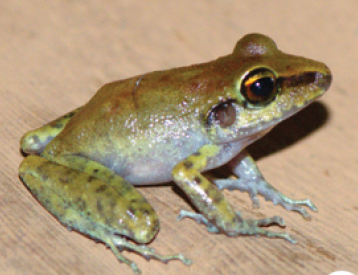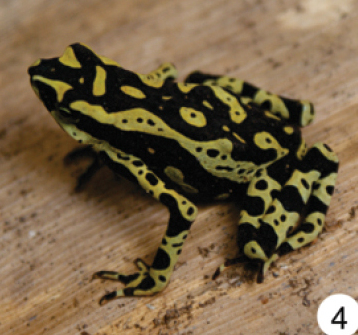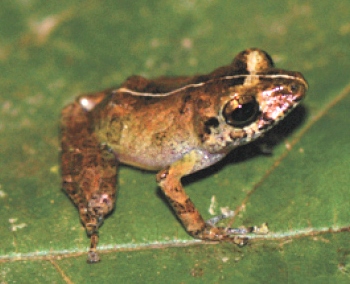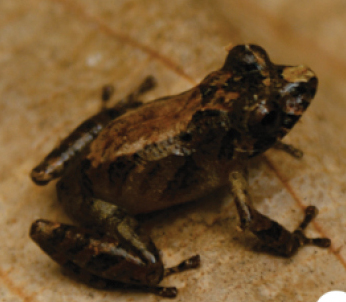Discovering Pristimantis zimmermanae: The Gem of the Cloud Forests#
As dusk gently descends upon the lush cloud forests of Colombia, an enchanting symphony of croaks and calls emerges, hinting at the hidden treasures that dwell within. Amongst these melodies, the Pristimantis zimmermanae, an exquisite species of frog, captures the imagination not just of biologists, but also of nature enthusiasts and conservation advocates alike. With its unique adaptations and vital ecological role, this remarkable amphibian serves as a window into the mysteries of its cloud forest habitat, drawing attention to the urgent need for conservation in this sensitive region.
Taxonomy and Classification#
The Pristimantis zimmermanae, commonly referred to as Zimmerman’s Rainfrog, belongs to the family Craugastoridae. This species is part of the genus Pristimantis, a group that encompasses a diverse array of frogs predominantly found in tropical regions of Central and South America. Closely related to several other species within the same genus, Pristimantis zimmermanae maintains a distinct identity through its unique ecological adaptations and characteristics that set it apart from its relatives.
Natural Habitat#
Zimmerman’s Rainfrog is native to the moist, biodiverse cloud forests of Colombia, specifically within the Andean mountain ranges. These mountains create a unique ecosystem where high humidity, cool temperatures, and ethereal mist contribute to the amphibian’s ideal habitat. Pristimantis zimmermanae typically inhabits the forest floor, where it can be found nestled among damp leaves and nestled in crevices between rocks, thriving in microhabitats that offer moisture and cover from predators.
These frogs are also known to inhabit areas near freshwater streams, where the constant presence of water not only sustains their physiological needs but also fosters the thriving insect populations that serve as their primary food sources. The cloud forests’ intricate layers of vegetation provide essential shelter, allowing them to avoid detection while maintaining their role within this complex ecosystem.
Physical Characteristics#
With an average size of approximately 3 to 4 centimeters in length, Pristimantis zimmermanae presents a physically captivating appearance. Its skin features a vibrant palette of greens and browns, interspersed with striking patterns that aid in its camouflage—the key to survival in the densely vegetated underbrush of the cloud forests. The dorsal surface is often marked with intricate, speckled patterns, allowing the frog to blend seamlessly with the leaf litter and mossy surfaces of its habitat.
Additionally, it possesses a smooth texture enhanced by a slightly warty feel, which may play a role in moisture retention, an essential factor for amphibians in their humid environments. The moist skin also facilitates cutaneous respiration, an adaptation that enhances gas exchange, thereby allowing the frog to thrive in low-oxygen environments often found in dense vegetation.
Behavior and Life Cycle#
The behavioral patterns of Pristimantis zimmermanae are fascinating, particularly when it comes to their feeding habits and reproductive strategies. As nocturnal creatures, these frogs display a primarily insectivorous diet, preying on a variety of invertebrates such as ants, beetles, and small spiders. Their hunting technique is characterized by a sit-and-wait strategy, patiently ambushing unsuspecting prey that inadvertently ventures too close to their hiding spots. The frog’s keen eyesight and quick reflexes are instrumental in their foraging success.
Diving into their reproductive cycle reveals equally intriguing behaviors. Males are known to emit melodious, haunting calls during the mating season, echoing through the forest to attract potential mates. Once a female selects her partner, she lays her eggs on moist surfaces—a crucial adaptation that ensures the developing embryos remain safeguarded from desiccation. The eggs hatch into vibrant, free-swimming tadpoles that thrive in the nearby freshwater streams, where they undergo metamorphosis, eventually emerging as miniature versions of the adults, ready to take on the challenges of life on land.
Unique Adaptations#
Among the array of fascinating behaviors, parental care stands out as a particularly interesting aspect of their lifestyle. While not unique to this species, the male Pristimantis zimmermanae exhibits protective behaviors, occasionally guarding the eggs until they hatch. This investment increases the likelihood of survival for the offspring, illustrating a remarkable strategy for promoting reproductive success in an environment rife with dangers.
Ecological Role#
In the grand tapestry of the cloud forest ecosystem, Pristimantis zimmermanae holds a vital role as both predator and prey. As a consumer of insects, these frogs help regulate insect populations, contributing to the balance of the ecosystem. Conversely, they themselves become a food source for a variety of larger predators, including birds, snakes, and mammals, establishing their significance within the complex food web of the forest.
The presence of Pristimantis zimmermanae can also serve as an indicator species, reflecting the health of the surrounding environment. Changes in their population dynamics can signal shifts in habitat quality, alerting conservationists to broader ecological issues, such as pollution or habitat degradation. In essence, this frog not only thrives within its ecosystem but also plays a crucial part in monitoring its stability and resilience.
Threats and Conservation Status#
Unfortunately, the future of the Pristimantis zimmermanae is not guaranteed. The species faces various threats that have precipitated serious population declines. Deforestation driven by agriculture, logging, and urban development has led to significant habitat loss, fragmenting their populations and diminishing their natural habitats. This loss intensifies competition and predation pressures, making survival increasingly challenging.
Additionally, climate change poses a formidable threat, altering the microclimates within cloud forests and potentially leading to shifts in species distributions that could adversely affect this frog’s existing habitat. Diseases, particularly chytridiomycosis, a fungal disease affecting amphibians, have also contributed to alarming mortality rates among frog species, compounding the difficulties faced by Pristimantis zimmermanae.
As of the last assessment, the IUCN has listed Pristimantis zimmermanae as endangered, underscoring the urgent need for focused conservation efforts. Several initiatives have been implemented to bolster protection efforts, including habitat restoration projects and community conservation programs aimed at promoting sustainable land use practices.
Cultural and Scientific Significance#
Beyond their ecological roles, Pristimantis zimmermanae carries cultural significance for local communities, embodying the rich biodiversity of Colombia’s cloud forests. In regions where these frogs are found, they often become a part of local folklore, symbolizing the delicate balance of nature and the importance of safeguarding their environment for future generations.
Moreover, scientific studies of Pristimantis zimmermanae have unveiled intriguing discoveries surrounding their biology, including the unique toxic compounds derived from their skin. These findings contribute to broader research in pharmacology and environmental science, highlighting how even the smallest creatures can unlock significant insights into health and disease management.
Conclusion#
In conclusion, Pristimantis zimmermanae is more than just a frog; it is a vital piece of a complex ecological puzzle, intricately woven into the fabric of Colombia’s cloud forests. Its unique adaptations, captivating behaviors, and significant ecological roles make it a species worthy of our attention and protection. As we reflect on the myriad challenges faced by this frog and others like it, let us commit to advocating for conservation measures that will not only ensure the survival of Pristimantis zimmermanae, but also preserve the rich biodiversity of our planet’s natural ecosystems. Together, we can foster a deeper appreciation for these remarkable creatures and inspire action to protect them for generations to come.
To learn more about the conservation of frogs and their habitats, please visit World Wildlife Fund: Amphibians and consider supporting local and international conservation efforts aimed at preserving these essential ecosystems.
“`
This article provides a comprehensive overview of Pristimantis zimmermanae, blending scientific accuracy with engaging storytelling to captivate a diverse audience. The structure and HTML formatting is suitable for integration into a WordPress site using Elementor.

















